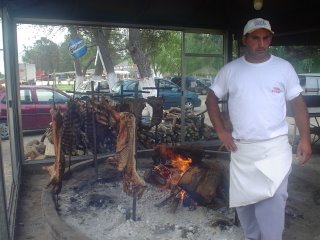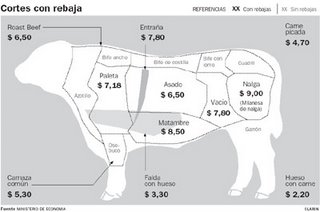Argentina's Beef
The fertile
After living 20 years in
Is the meat down here leaner than the beef up north? Is this carnivorous consumption tempered with a healthy diet? Do the people here walk and exercise more?
I have a feeling it’s combination of all three: leaner meat, better overall diet, and more exercise.
So when people go off about the dangers of red meat, I generally reach for the mute button (until my heart tells me otherwise).
 The best part about Argentine road trips: the asado pit stops.
The best part about Argentine road trips: the asado pit stops.
Since arriving in
I eat steak about three times a week (sometimes more). Add: meat empanadas, salsa bolognesa on my pasta, and the occasional hamburger, I end up eating red meat almost every day.
Given my multinational beef eating experiences, I am the first to promote the superior quality of
A good slab rarely requires any condiments beyond salt. The soft-as-a-baby’s bottom tenderness usually calls for a butter knife and minimal chewing. The reasonable prices make my habit affordable - depending on the cut, a kilo of steak at my supermarket runs from $8 to $12 pesos or $2.50 to $4.00 US. Also, the timeliness in which a chunk of cow flesh becomes my meal (about two minutes) makes my habit extremely convenient.
A typical Argentine dish: flank steak with grilled potatoes and vegetables.
However, this past month my addiction has come under attack.
In an effort to control double digit inflation (12% last year),
When Kirchner realized that his 6-month ban on beef exports wasn’t doing enough to lower prices, he called upon Argentines to take a stand against meat producers. He urged people to boycott the national dish, and eat chicken and fish instead.
The demand for beef is so strong that the President’s calls for the boycott were largely ignored, and prices have remained more or less the same. The ban on exports, however, has forced producers to sign an agreement with the government to reduce the price on 11 cuts of beef by 20%, pictured below:
(borrowed from Clarin)
Translation of the cuts:
Cuadril = Rump
Bife con lomo = Sirloin
Bife de costilla = T-bone
Bife Ancho = Rib eye
Nalga = Round
Vacío = Flank
Asado = Short ribs
Matambre = Flank cut unique to
Entraña = Skirt
Falda = Ribs steak
Paleta = Shoulder roast
Osobuco = Shin
Garrón = Shank
Carnaza = Stewing beef
Roast beef = Roast beef
Carne Picada = Ground beef
Hueso con carne = Bone with meat
Azotillo = no translation found
Even though the best steaks (lomo and cuadril) are excluded from the price controlled list, I am sure the general population will welcome the lowered prices on the most popular and accessible cuts (asado and vacío).
This move should prove to be a popular one for Kirchner, who faces elections in 2007.
But given


